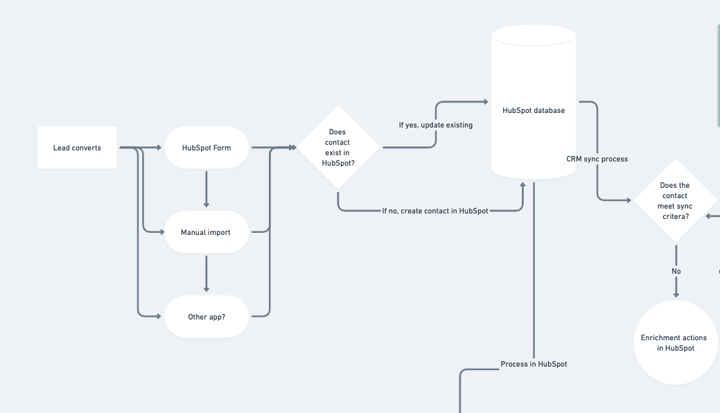5 Reasons Your B2B SaaS Business Needs Marketing Operations.
Are you a marketing leader and wondering how to make the business case to hire Marketing Operations support? This blog lists 5 good reasons why you should leverage a MOPS specialist.
Marketing leaders drive a company's marketing efforts by creating compelling content that grabs the attention of the target audience and generates demand. They strategically deliver this content through various channels to capture interest. Marketing operations ensure a smooth customer experience by organizing and normalizing data, routing leads, tracking customer relationships, and attributing leads to marketing activities. This helps marketing leaders tailor their efforts and connect marketing activities to revenue, driving business growth.
Demand Capture
This is the pivotal moment when a potential customer becomes aware of your brand and expresses interest by filling out a form. By engaging with your content, they have taken a significant step towards becoming a valuable lead. This act not only signifies their interest but also grants you the opportunity to nurture and guide them through their customer journey. Once they enter your marketing automation software, you have the power to establish a meaningful connection and provide them with a seamless customer experience.
Upon entering your marketing automation software, it is crucial to ensure that the data is cleaned and organized. This process of data normalization enables you to maintain accurate and up-to-date information about each lead. By keeping their data organized, you can gain valuable insights into their demographics, preferences, and behaviors, allowing you to tailor your marketing efforts effectively.
The next step in demand capture is routing the lead to the right place within your marketing funnel. This involves the implementation of lead routing and lead scoring strategies. Through these processes, you can determine whether a lead is ready to be contacted by a sales representative or if they require further nurturing. By directing each lead to the appropriate stage in the funnel, you can optimize your resources and ensure that each lead receives the attention they deserve.
Keeping track of the customer's relationship with your brand is another vital aspect of demand capture. This is achieved through lifecycle stage automation, which allows you to understand where each customer is in their journey. By identifying their particular stage, you can deliver targeted content and offers that resonate with their specific needs and interests. This personalized approach not only enhances the customer experience but also increases the likelihood of conversion and long-term loyalty.
In addition to tracking the customer's relationship, it is equally important to track where each lead originated from. This can be done through self-reported information provided by the customer or through automated attribution strategies. Understanding the source of each lead provides valuable insights into the effectiveness of your marketing activities. By identifying which channels or campaigns are driving the most leads, you can optimize your efforts and allocate resources strategically.
Lastly, demand capture involves connecting your marketing activities to revenue. This is achieved through the implementation of attribution strategies, which allow you to measure the impact of your marketing efforts on the bottom line. By analyzing the revenue generated from each marketing activity, you can make data-driven decisions and allocate resources more effectively to generate maximum return on investment. This ensures that your marketing efforts are not only driving awareness and demand but also contributing to the overall growth and success of your business.
Demand capture is a critical component of marketing operations, enabling marketing leaders to effectively engage potential customers and guide them through their customer journey. By implementing strategies such as data normalization, lead routing, lifecycle stage automation, and attribution, marketing leaders can ensure a seamless customer experience and maximize the impact of their marketing efforts.
Automation processes you need
When a user enters your automation software you need to have a few processes running:
1) Ensuring their data is meticulously organized and maintained. (Data normalization)
Data normalization plays a crucial role in marketing operations as it ensures that the data collected from potential customers is accurate, complete, and organized. This process involves standardizing and structuring the data to eliminate any inconsistencies or redundancies. By normalizing the data, marketing leaders can gain valuable insights into their target audience and make informed decisions to drive their marketing strategies.
One aspect of data normalization is cleaning and validating the data. This involves removing any duplicate or incorrect entries, as well as verifying the accuracy of the information provided by the leads. By eliminating duplicates and ensuring the correctness of the data, marketing leaders can avoid any confusion or misunderstandings when engaging with potential customers.

Another aspect of data normalization is categorizing and organizing the data. This involves creating a systematic structure for storing and retrieving the data, such as using standardized fields and formats. By categorizing the data into relevant categories, marketing leaders can easily analyze and segment their target audience, allowing them to tailor their marketing efforts to specific customer segments.
Additionally, data normalization enables marketing leaders to integrate data from different sources. This could include data collected from various marketing channels, such as social media platforms, email marketing campaigns, or website analytics. By integrating data from different sources, marketing leaders can gain a comprehensive view of their target audience and identify patterns or trends that can inform their marketing strategies.
Moreover, data normalization facilitates data analysis and reporting. By organizing the data in a structured manner, marketing leaders can easily extract insights and generate reports that provide valuable information about the effectiveness of their marketing campaigns. This allows them to measure the impact of their efforts, identify areas for improvement, and make data-driven decisions to optimize their marketing strategies.
In conclusion, data normalization is a critical step in marketing operations that ensures the accuracy, completeness, and organization of the data collected from potential customers. By cleaning and validating the data, categorizing and organizing it, integrating data from different sources, and facilitating data analysis and reporting, marketing leaders can gain valuable insights into their target audience and optimize their marketing strategies for maximum impact and success.
2) Directing the lead towards the optimal path. Are they ready to be nurtured or are they primed for sales? (Lead Routing and Lead Scoring)
Lead routing and lead scoring are essential components of marketing operations that help guide potential customers toward the most appropriate path – whether it's nurturing them further or passing them on to the sales team.
Lead routing involves the process of assigning leads to the right individuals or teams within your organization based on specific criteria. This ensures that each lead receives the appropriate attention and is handled by the most qualified person. By implementing lead routing strategies, marketing leaders can streamline their lead management process and optimize their resources. For example, if a lead has expressed interest in a particular product or service, they can be directed to a sales representative who specializes in that area, increasing the chances of conversion.

Lead scoring, on the other hand, involves assigning a numerical value to each lead based on their level of engagement and readiness to make a purchase. This allows marketing leaders to prioritize their efforts and focus on leads that are more likely to convert. Lead scoring is typically based on factors such as the lead's interactions with your website, email campaigns, and other marketing touchpoints. By assigning scores to leads, marketing leaders can identify those that require further nurturing and those that are ready for direct sales engagement.
By combining lead routing and lead scoring, marketing leaders can ensure that each lead is directed towards the optimal path. For example, leads with high scores indicating strong engagement and interest can be routed directly to the sales team for immediate follow-up. On the other hand, leads with lower scores may be sent to the marketing team for further nurturing through targeted content and personalized communication. This systematic approach not only saves time and resources but also increases the efficiency and effectiveness of the overall lead management process.
In conclusion, lead routing and lead scoring are critical components of marketing operations that help guide potential customers towards the most appropriate path. By implementing these strategies, marketing leaders can ensure that each lead receives the right level of attention and is directed towards the most relevant engagement, whether it's further nurturing or direct sales engagement. This not only optimizes the lead management process but also increases the chances of conversion and ultimately drives business growth.
3) Monitor and nurture their engagement with your brand. (Lifecycle Stage Automation)
Lifecycle stage automation is a crucial aspect of demand capture that enables marketing leaders to effectively monitor and nurture the engagement of potential customers with their brand. This process involves tracking and analyzing the customer's journey through various stages, from the initial awareness of your brand to becoming a loyal customer.
By implementing lifecycle stage automation, marketing leaders can gain a comprehensive understanding of where each customer is in their journey and tailor their marketing efforts accordingly. This allows them to deliver targeted content and offers that resonate with the specific needs and interests of each customer, ultimately enhancing their experience and increasing the likelihood of conversion and long-term loyalty.
The first stage of the customer lifecycle is the awareness stage, where potential customers become aware of your brand and its offerings. At this stage, marketing leaders can leverage various marketing channels, such as social media, content marketing, and advertising, to create brand awareness and capture the attention of potential customers.

The next stage is the consideration stage, where potential customers actively evaluate your brand and compare it to competitors. Marketing leaders can use personalized content, such as case studies, testimonials, and product demonstrations, to showcase the unique value and benefits of their offerings and persuade potential customers to choose their brand.
Once potential customers have made a decision and become customers, they enter the acquisition stage. At this stage, marketing leaders can focus on delivering exceptional customer service and ensuring a smooth onboarding process to create a positive experience and solidify the customer's relationship with the brand.
The fourth stage is the retention stage, where marketing leaders aim to retain existing customers and foster long-term loyalty. This can be achieved through personalized communication, exclusive offers, loyalty programs, and ongoing customer support. By nurturing the engagement of existing customers, marketing leaders can maximize customer lifetime value and drive repeat purchases.
The final stage of the customer lifecycle is advocacy, where satisfied customers become brand advocates and actively promote your brand to others. Marketing leaders can leverage customer testimonials, referral programs, and user-generated content to encourage advocacy and amplify the reach and impact of their marketing efforts.
Through lifecycle stage automation, marketing leaders can effectively monitor the progression of each customer through these stages and deliver targeted content and offers that align with their specific needs and interests. This personalized approach not only enhances the customer experience but also increases the likelihood of conversion, retention, and advocacy.
In conclusion, lifecycle stage automation is a vital component of demand capture that enables marketing leaders to monitor and nurture the engagement of potential customers with their brand. By understanding where each customer is in their journey and delivering targeted content and offers, marketing leaders can optimize their marketing efforts, drive customer conversion and retention, and ultimately contribute to the overall growth and success of their business.
4) Gain insights into the lead's source. (Self-Provided and Automated Attribution)
In order to optimize marketing strategies and understand the effectiveness of various lead generation channels, it is crucial for marketing leaders to gain insights into the source of each lead. By knowing where leads are coming from, whether it's through self-provided information or automated attribution, marketing leaders can make data-driven decisions and allocate resources more effectively.
Self-provided attribution refers to when leads voluntarily provide information about how they discovered your brand or product. This can be done through forms on your website, surveys, or during conversations with your sales or customer service teams. By collecting this information, marketing leaders can gain valuable insights into which channels or campaigns are resonating most with their target audience. For example, if a significant number of leads mention that they discovered your brand through a specific social media platform, it indicates that your social media marketing efforts are paying off and should be further optimized.
On the other hand, automated attribution involves the use of marketing analytics tools to track and attribute leads to specific marketing channels or campaigns. This can be done through the use of tracking codes, cookies, and other technologies that monitor a lead's journey from the initial touchpoint to the conversion. By leveraging automated attribution, marketing leaders can accurately measure the impact and ROI of their marketing efforts. For instance, if a particular email marketing campaign is generating a high number of leads and conversions, it indicates that the campaign is resonating well with the target audience and should be replicated or optimized for even better results.


By combining self-provided and automated attribution, marketing leaders can gain a comprehensive understanding of the lead's source and the effectiveness of their marketing channels. This allows them to make informed decisions about where to invest their resources and which channels to prioritize. For example, if self-provided attribution data shows that a significant number of leads are coming from referral sources, marketing leaders can focus on building and nurturing relationships with key influencers or implementing a referral program to further amplify their reach.
In conclusion, gaining insights into the lead's source is crucial for marketing leaders to optimize their strategies and allocate resources effectively. By leveraging self-provided and automated attribution, marketing leaders can understand which channels are driving the most valuable leads, make data-driven decisions, and continuously improve their marketing efforts for maximum impact and success.
5) Link Marketing activities to revenue (Return on Investment)
In today's competitive business landscape, marketing leaders are constantly striving to demonstrate the value and impact of their marketing efforts. Establishing a direct link between marketing activities and revenue generation is crucial for proving the return on investment (ROI) of marketing campaigns and securing budgets for future initiatives. This is where attribution comes into play.
Attribution is the process of assigning credit to different marketing touchpoints or channels that contribute to the final conversion and revenue generation. By accurately attributing revenue to specific marketing efforts, marketing leaders can gain valuable insights into which campaigns, channels, or strategies are driving the most revenue and adjust their marketing strategies accordingly.
There are several attribution models available for marketers to choose from, each with its own strengths and limitations. The most common attribution models include first-touch attribution, last-touch attribution, and multi-touch attribution.
First-touch attribution assigns all the revenue credit to the first marketing touchpoint that the lead interacts with. This model is useful for understanding which channels are effective at generating initial awareness and capturing the attention of potential customers.
On the other hand, last-touch attribution gives all the revenue credit to the final marketing touchpoint before the conversion. This model is beneficial for identifying the last marketing efforts that directly influenced the lead to make a purchase.
 Multi-touch attribution takes into account all the marketing touchpoints that the lead interacted with throughout their customer journey and assigns credit to each touchpoint accordingly. This model provides a more comprehensive view of the customer journey and allows marketing leaders to understand the contribution of each touchpoint toward revenue generation.
Multi-touch attribution takes into account all the marketing touchpoints that the lead interacted with throughout their customer journey and assigns credit to each touchpoint accordingly. This model provides a more comprehensive view of the customer journey and allows marketing leaders to understand the contribution of each touchpoint toward revenue generation.
To establish a direct link between marketing efforts and revenue generation, marketing leaders need to implement a robust attribution strategy that aligns with their specific business goals and objectives. This involves setting up tracking mechanisms, such as UTM parameters, conversion tracking pixels, or marketing automation platforms, to capture and analyze data from various marketing touchpoints.
By leveraging attribution data, marketing leaders can identify which marketing efforts are driving the most revenue and optimize their strategies accordingly. For example, if a specific email campaign is consistently generating high revenue, marketing leaders can replicate the success of that campaign in future efforts or allocate more resources to email marketing.
Furthermore, attribution data can also help marketing leaders identify any gaps or inefficiencies in their marketing funnel. If a particular touchpoint is not generating significant revenue, marketing leaders can investigate and make necessary adjustments to improve its performance.
Overall, establishing a direct link between marketing efforts and revenue generation through attribution is essential for marketing leaders to demonstrate the impact and ROI of their campaigns. By accurately attributing revenue to different marketing touchpoints, marketing leaders can make data-driven decisions, optimize their strategies, and contribute to the overall growth and success of the business.
These fundamental steps are the building blocks of a successful marketing operation. While they may be considered basic, they are absolutely crucial in ensuring the seamless flow of your marketing efforts.
Marketing operations plays a crucial role in ensuring a seamless customer experience by guiding leads to the right place and demonstrating the impact of marketing efforts on the business. It enables marketing leaders to optimize the customer journey and showcase the value that marketing brings to the company.
Are you still making the case for a Marketing Ops specialist on your team? Get in touch if you'd like to know how we can work together.






